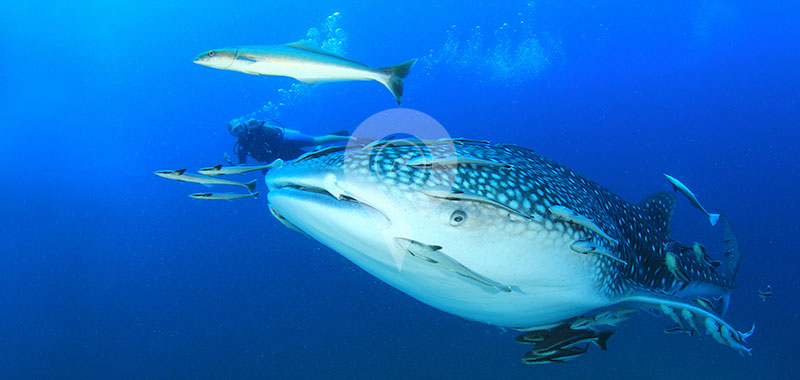The Whale Shark (_Rhincodon typus_), also known as 'Tiburón Ballena' in Spanish, holds the title of the largest fish in the ocean. Regularly visiting the Galapagos Marine Reserve, this species is currently classified as endangered. Noted for their imposing size, Whale Sharks are also distinguished by their peaceful demeanor, making them a focal point of interest for marine biologists and ocean enthusiasts alike.
Size and Appearance
Reaching staggering lengths of up to 20 meters and weights exceeding 30 metric tonnes, Whale Sharks possess a distinctive appearance. Their skin is primarily grey to blue, adorned with unique white spot patterns amidst vertical and horizontal stripes, creating a chequerboard effect. The head of a Whale Shark is characteristically broad and flat, equipped with a large mouth that can span up to 1.5 meters wide. In contrast, their eyes are relatively small in proportion to their body size.
Habitat and Distribution
Global Presence
Whale Sharks exhibit a wide geographical range, inhabiting warm and temperate seas globally, with the notable exception of the Mediterranean Sea. Their migratory nature often leads them to coastal locations where predictable aggregations, known as 'whale shark seasons,' occur. These aggregations are typically linked to local surges in marine productivity, such as coral or fish spawning events.
Galapagos Habitat
In the Galapagos, Whale Sharks are predominantly observed in the northern waters near Darwin and Wolf Islands. Darwin’s Arch, in particular, serves as a notable feeding ground, attracting these giants due to the upwelling currents that bring a rich supply of plankton.
Behavior and Diet
Feeding Habits
Whale Sharks are primarily planktivores, subsisting on a diet of plankton, small fish, krill, and fish eggs. Remarkably, they can consume up to 90 pounds of food each day. Their feeding technique, known as ram-filter feeding, involves swimming near the ocean surface with their mouths open wide, allowing them to channel plankton-rich water for sustenance.
Migration and Behavior
The migratory routes of Whale Sharks encompass thousands of miles each year, linking feeding grounds across the globe, including the western coast of Australia, Indonesia, Belize, and the Galapagos Islands. Despite their size, Whale Sharks are surprisingly inefficient swimmers, traveling at a speed of just over 3 miles per hour and relying on their entire body for propulsion, a unique trait among fish species.
Reproduction and Lifecycle
Breeding Behavior
The reproductive cycle of Whale Sharks remains largely enigmatic. Known to give birth to live young, studies suggest they employ ovoviviparous reproduction, where eggs hatch inside the female before birth. A single pregnant female can carry more than 300 eggs. Upon birth, baby Whale Sharks measure between 40-60 cm and exhibit rapid growth rates of approximately 18 inches per year.
Galapagos Significance
The Galapagos waters are a significant habitat for predominantly female Whale Sharks, a large proportion of which appear to be pregnant. This unusual demographic distribution is a subject of ongoing scientific investigation, with researchers seeking to understand the reasons behind this aggregation pattern.
Conservation Status and Efforts
Endangered Status
The Whale Shark faces the threat of endangerment, primarily due to factors such as illegal fishing, unintentional capture in fishing nets (bycatch), and collisions with ships. Their role as nutrient carriers across marine ecosystems underscores their ecological importance. Consequently, international trade in Whale Shark meat or products is prohibited under CITES (The Convention on International Trade in Endangered Species of Wild Fauna and Flora).
Research and Protection
Projects like the Galapagos Whale Shark Project aim to deepen our understanding of Whale Shark migratory patterns, behaviors, and potential birthing sites. This research is pivotal for the development of effective conservation strategies. Efforts also include environmental education for local communities to foster participation and support for conservation actions.
Best Time and Places to Observe
Optimal Season
The prime season for observing Whale Sharks in the Galapagos spans from June to November, with peak sightings occurring in August and September. However, due to the variable nature of their presence, sightings are not guaranteed, even during peak season.
Prime Locations
Darwin and Wolf Islands in the northern Galapagos are the prime spots for encountering these creatures, with Darwin Island offering consistent opportunities for divers to observe adult female Whale sharks.
Why GreenGo Travel?
Here at GreenGo Travel we’re passionate about nature, adventure & fun! An amazing world is waiting to be discovered… we get you there sustainably & hassle free. An easy to understand, rich in content portal that demystifies the process of traveling in Ecuador, the Galapagos Islands & Peru. No two clients are alike, we provide free & complete customization of your trip tailored by local experts, empowering you to travel like a local. Get to know all the in & outs before and during your travel.
Our Commitment to You
- Best Price Guaranteed
- Free Personalized Trip Planning
- Over a Decade of Experience
- Local Ecuadorian, Galapagos & Peru Experts
- 99% customer satisfaction for online reviews
Tailored Customer Relationship Management
- Unique Custom In-House Booking System
- Largest Database of Galapagos Cruises
- Personalized Account to Track Your Booking
- AI powered Solutions for Improved Support
- Unparalleled Information Pre & Post Booking
24/7 Customer Support: Our Ecuador, Galapagos & Peru Experts, are ready to plan your next trip.

Fun Fact
The Whale Shark is that despite being the largest fish in the ocean, they are gentle giants, primarily feeding on plankton and small fish. Whale Sharks are filter feeders and can consume up to 90 pounds of plankton and small marine organisms each day. They do this by swimming with their mouths open wide, filtering water through their gills, and capturing food with their 350 rows of tiny teeth?.
